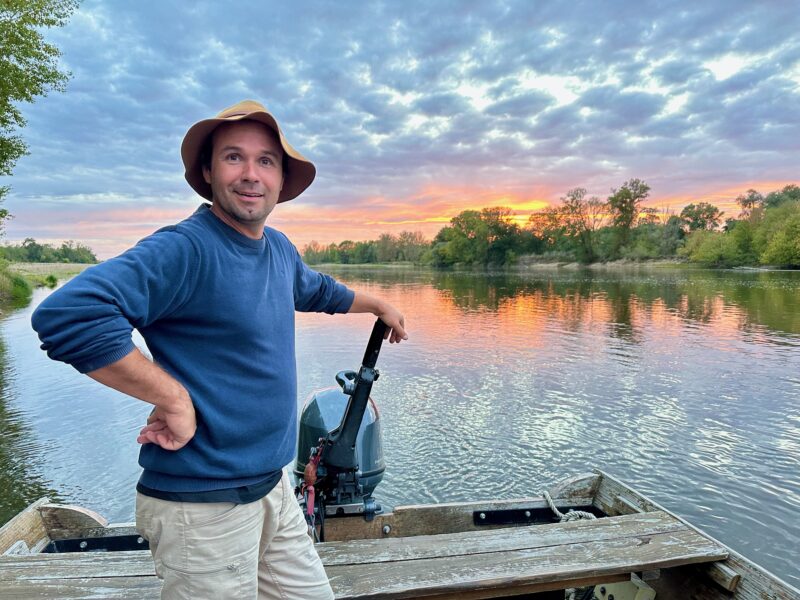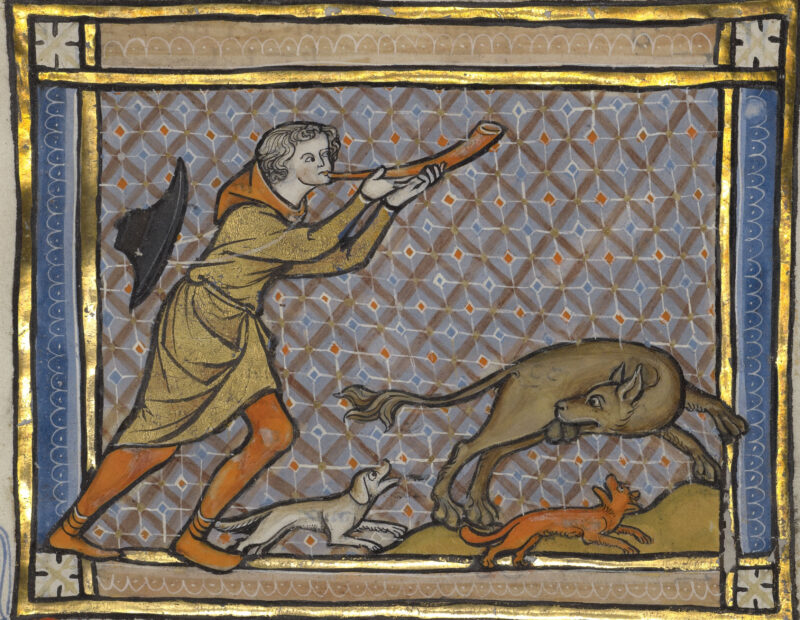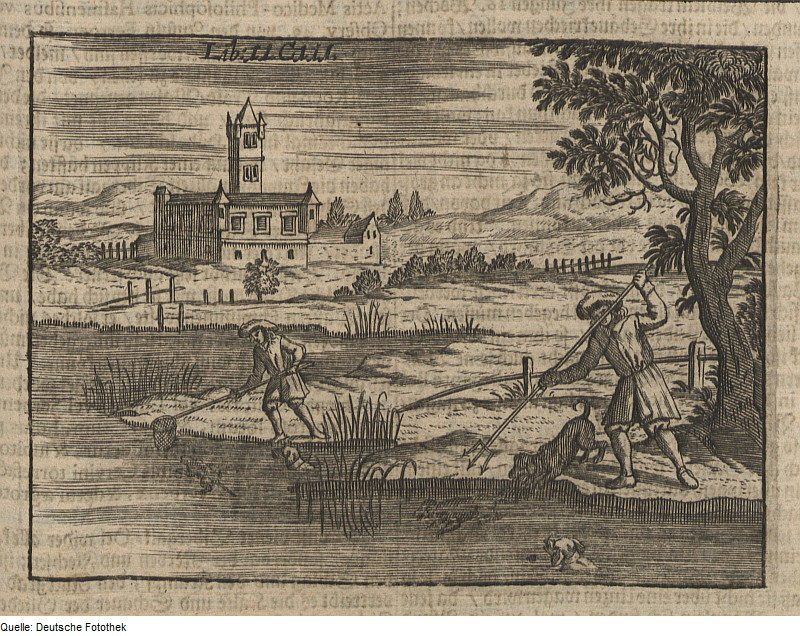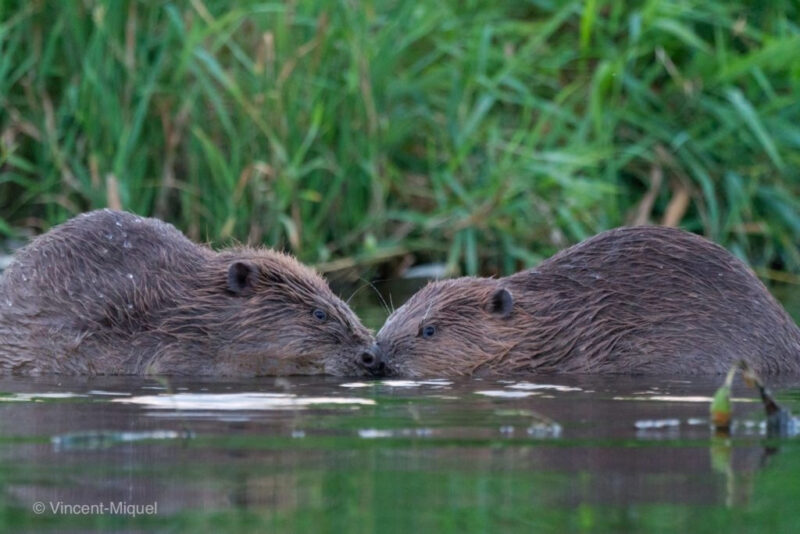
The Eurasian Beaver: The Long Road to Survival
by Chloe Destremau
 Earlier this year, as we drifted down the Loire River, we came across a furry head cleaving the surface. To our delight, it turned out to be a Eurasian Beaver, Castor fiber, the biggest rodent of Europe. That evening, we did not see just one but ten beavers (photo above), swimming and foraging for leaves, twigs, and cattails in the crimson water of dusk. « In fifteen years on the river, I have never seen so many, » Aurélien (photo right), our toue navigator, told us in awe. « We are lucky. » And so we felt lucky.
Earlier this year, as we drifted down the Loire River, we came across a furry head cleaving the surface. To our delight, it turned out to be a Eurasian Beaver, Castor fiber, the biggest rodent of Europe. That evening, we did not see just one but ten beavers (photo above), swimming and foraging for leaves, twigs, and cattails in the crimson water of dusk. « In fifteen years on the river, I have never seen so many, » Aurélien (photo right), our toue navigator, told us in awe. « We are lucky. » And so we felt lucky.
As the Château Royal d’Amboise rose into view and the last beaver cut across the current, I found myself wondering where this animal had stood in our world of kings, hunters, and naturalists, and how it had survived our centuries of dominion.
A Creature of Myths and Misunderstandings
From Antiquity to the Middle Ages, the beaver was a creature of fables as much as of rivers. Legends claimed it gnawed off its own testicles when chased, a grotesque act repurposed as a moral allegory: man, too, must sacrifice to evade the devil’s grasp.
The myth was revisited in the 16th century, when naturalists questioned the beaver’s biology and physiology; could it truly twist its neck so far? And, could it climb? Did it use its tail as a hammer? Some said a lazy beaver could plop on its back, carry a trunk with its limbs while being dragged by its tail. Curiously, little attention was paid to the very behavior we most associate with the species today: dam building.
Direct observation was scarce already, and imagination filled the gaps. By the 16th century, in France, the animal had already retreated to the Rhône and the Camargue deltas, dwindling under relentless human pressure.

Illumination on parchment, 1260
An Animal of Many Uses
Even as its biology remained obscure, its value as a resource was clear. Its fur, exquisite in its permeability and warmth, was heavily sought for centuries. Most often hunted in the winter months for its thicker coat, once the animal was skinned and the multiple layers harvested, its fur was turned into various types of hats (e.g., chapkas) and coats, and its leather could be turned into gloves. During the medieval period, beavers were also a common food source, with younger meat being more favorable than the more mature texture of the adults. And, the substance it secreted for territorial marking—from glands mistaken for testicles in legends— called castoreum, was utilised in pharmacopeia, fragrance, and perfumes.
The beaver’s fate reflected a worldview in which nature was considered inexhaustible and designed for human exploitation.
As such, we settled on their riverbanks, built our homes as we saw fit, and cultivated the land, for we, too, required food to survive, and paid no mind to our neighbors. Initially, beavers ate our crops, flooded agricultural areas with their dams, and destroyed cultivated trees. They became a nuisance in our newly anthropic ecosystem. There was, however, a solution, and killing beavers was encouraged and even rewarded.
Beavers died while we continued on plowing the habitat they had transformed so ingeniously. Subsequently, they disappeared: first in England during the 12th century, soon followed by the remainder of the British Isles. Gradually, throughout the 1800s, it vanished from our continent, like a gullet slowly closing; Spain and Italy, then Asian and Scandinavian territories, until the last populations in Central Europe finally collapsed as well.
We drove them away from their habitat, and the lucky few remaining wandered the industrialised landscape and adapted; they inhabited dens instead of huts, they stopped building dams, and became solely nocturnal.

The Beaver Hunt, copper engraving, c. 1695.
Collapse and Survival
By 1900, Castor fiber teetered on the edge of extinction, reduced to a handful of fragmented populations across Europe, totaling a mere 1,200 individuals. Ironically, only when their disappearance seemed imminent did conservation stir.
The first conservation measures were taken in Scandinavia. Norway passed the first protection in 1863, followed by Finland, after its last beaver was killed. Sweden introduced protections two years after its population was extirpated. On the dawn of the Second World War, Finland released North American beavers, unbeknownst to them that these beavers were a distinguished species from the Eurasian.
In France, naturalists persuaded the social elite that the beaver was not vermin, but part of the nation’s natural heritage —a remnant of the wild worth preserving. In 1909, a decree prohibited hunting in the lower Rhône Valley, offering the species its first real protection. That population gradually rebounded, and from 1957 onwards, served as the source for reintroductions across the country.
Remarkably, the return of a species that had been absent for generations provoked little resistance. Instead of annoyance, its presence often inspired curiosity and even wonder in locals.
Today, over a million Eurasian beavers are estimated worldwide, most in northwestern Russia and Scandinavia, with other populations scattered across Europe and Central Asia. China also harbors a small but growing population of a subspecies, C. f. birulai, estimated at about 500 individuals.
In France, the population is estimated to be around 20,000 individuals across 18,000 km of waterways. However, while global numbers are healthy and steadily increasing, beavers are still rare at the regional level. In Pays de la Loire, where we saw our ten beavers, the species is listed as near threatened, with only a few hundred individuals recorded.

Ulisse Aldrovandi (1522 – 1605)
The Engineer Returns
With recolonization came the return of their ancient craft. Beavers do not build dams for the fun of it. They build to survive: to keep the entrances of their lodges submerged, safe from predators. When water levels drop, they dam the river to raise them. By flooding an area, they also extend their foraging range inland, securing more resources.
The effects ripple outward. Wetlands form where dams slow currents, becoming havens for migratory birds, amphibians, and aquatic plants. New channels deliver water to parched areas, fostering vegetation, insects, and the wildlife that feeds on them. Stored water buffers droughts in summer and reduces wildfire risk. In forests, beaver foraging opens light gaps, attracting bats and amphibians. Trees gnawed at the base sprout new growth, their root systems thickening and binding the soil, strengthening riverbanks against flood.
The beaver is not just a survivor; it is an ecosystem engineer. They modify and alter the available resources in an ecosystem, thereby shaping one habitat into another.
Despite their recovery, the beaver’s genetic legacy remains fragile. The modern European populations stem from only a few isolated refuges that survived into the early 20th century. This severe bottleneck left them with markedly reduced genetic variability. Such homogeneity increases the risks of inbreeding, lowers resilience to pathogens, and constrains their ability to adapt to climate change or shifts in habitat.
While numbers and distribution have expanded impressively, the species still carries the imprint of its near-extinction in its genes, making long-term management crucial.

Vicent Miquel, 2013
The beavers we saw this summer evening near the Château d’Amboise are heirs to this long story. Once demonized in fables, hunted to the brink, and banished from most of Europe, they now swim again in our rivers thanks to conservation and their own tenacity. Their presence embodies both the violence of human exploitation and the resilience of life when given the chance to return.

Note about the writer: Chloe Destremau is a freelance writer and the daughter of Christy Destremau, founder and owner of France Off the Beaten Path Tours.
Ready for your journey to discover the enchanting world of France?
- Check out our ALL of our 2026 tour dates.
- Contact us at christy@traveloffthebeatenpath.com to request space availability and/or ask questions.
- Message us on WhatsApp at +1.717.683.2827


